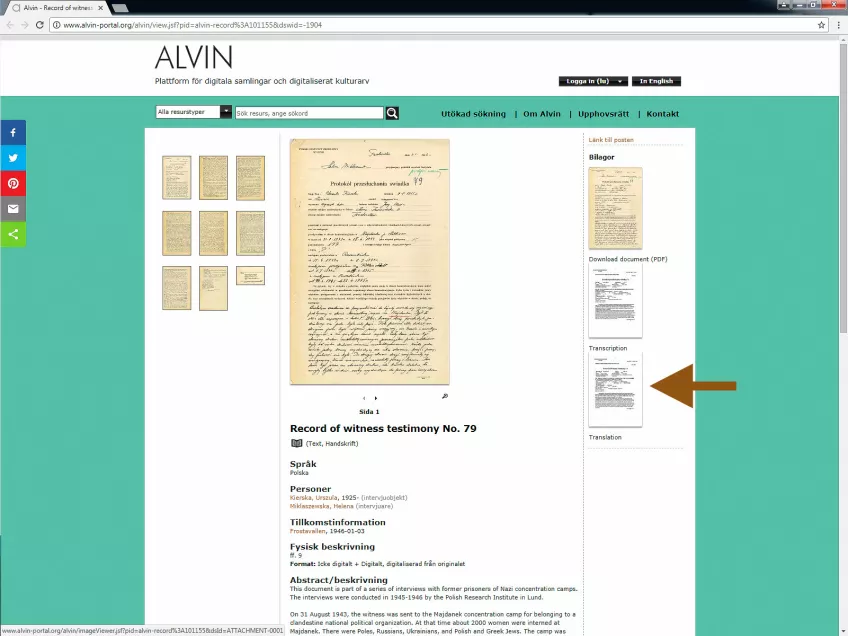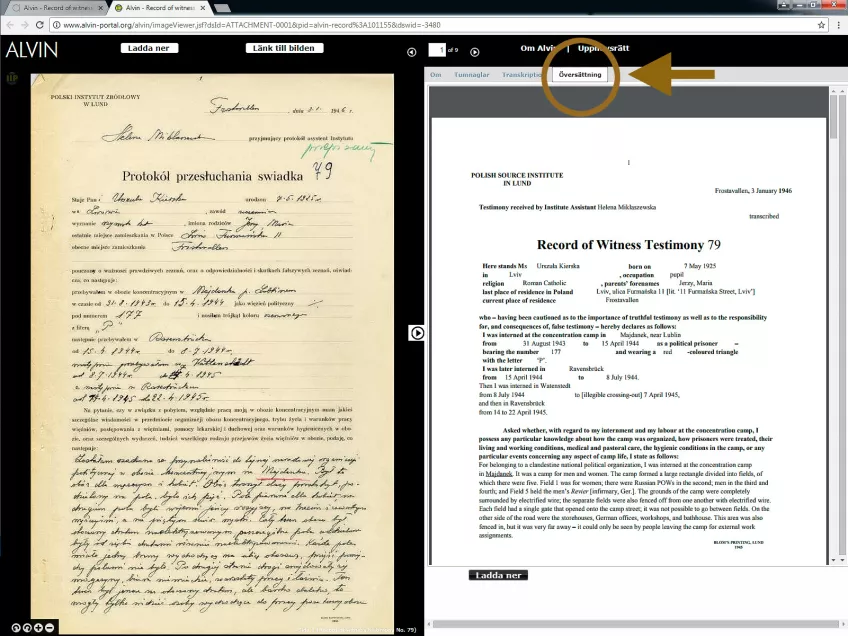Search guide to the digital collection
The core of the archive is composed of 512 in-depth interviews with Polish survivors from Nazi concentration camps, conducted shortly after their liberation. All the testimonies are available online. The archive also contains documents and materials brought to Sweden by survivors, and material that the Polish Research Institute compiled as reference resources.
As the archive is very large, only a selection has been digitized. To browse the digitized material, please see the main page. To read a complete list of the physical archive, please see the archival description.
Most of the archive material is in Polish, and to increase accessibility the interviews are in the process of being translated into English. New translations are continually added as attachments to the digitized original document.
There are two ways to access the translations. To open the translation as a PDF file and to download it, use the attachments on the right (image 1). In order to view the translation and the original document side by side, click the main image to enter the image viewer, and then click ”Translation” (image 2).
To open the translation as a PDF file and to download it, use the attachments on the right.
To view the translation and the original document side by side, click the main image to enter the image viewer and then click ”Translation”.
How do I find information on a specific topic?
The digitized material has been tagged with subject headings to make it possible to find information on a specific topic. A selection of themes is available from the main page, while the complete list can be browsed under subject headings and geographical headings. Clicking on one of the headings will generate the material of relevance to the topic or place.
How do I find information on a specific individual?
If you are looking for information on a specific person, there are several ways to proceed.
- Check this list to see if the person was interviewed by the institute.
- Check these lists to see if the person was among the evacuees brought to Sweden by the Red Cross or the United Nations Relief and Rehabilitation Administration. Note that the lists are ordered according to gender first and then name. Not all refugees that came to Sweden arrived though rescue missions.
- Check if the person is mentioned in these lists of people at different refugee camps in Sweden.
- If the person was imprisoned at Ravensbrück concentration camp, you can check the transport lists to and from the camp. The lists are ordered chronologically, and you can orientate by date by clicking on the main image and then “Thumbnails”.
- Search the person’s name in the database Alvin in order to search the metadata on the digitized material.
- Search the person’s name in the archival description, in order to search the metadata on both the digitized and non-digitized material.
Remember to try different spellings and the person’s maiden name. If you do not find any information on the person, it does not necessarily imply that he or she is not mentioned in the archive. The person might appear in a photograph but never been identified. The person might also be mentioned in a notebook or work journal, or indirectly in a testimony. This kind of investigation often requires a large amount of research.
Examples from the collection
Witness testimonies
The Polish Research Institute conducted more than 500 interviews with survivors in 1945-1946. The witness testimonies were intended to be used as evidence in war trials and as sources for historical research. For this reason, the interviews were conducted as objectively and impartially as possible by using a set of general questions which allowed the survivors to recount their personal experiences in an ordered way. The interviewers were careful to distinguish between facts and the interviewee’s emotions, often including a short statement on the trustworthiness of the witness at the end of the recorded interview.
No group suffered as hard by the Nazi genocide as the Jewish population of Europe. But the Jews were not the only group of people persecuted by the Nazis. Among the victims of the concentration camps were also political dissidents, Romani, homosexuals, mentally and physically disabled people, Jehovah’s Witnesses, Baptists, Roman Catholics, communists and socialists. A majority of the interviewees in the Polish Research Institute archive were Polish Catholics imprisoned for political reasons, whereas merely 12% were Jewish. Rather than reflecting any partialities of the working group conducting the interviews, these figures reflect the fact that very few Jews survived to testify.
A majority of the interviewees had been imprisoned at Ravensbrück, a concentration camp for women and children located 90 km north of Berlin. Many survivors had been transferred from camp to camp during the war, and the interviews also detail events and experiences from a number of other concentration camps, including Auschwitz, Bergen-Belsen, Dachau, Majdanek, Neuengamme, and Sachsenhausen.
Here are three examples, showing the width of the recorded experiences:
-
Interview 23: Leonarda Dal-Trozzo, 63 years old, Catholic, imprisoned at Ravensbrück
-
Interview 79: Urszula Kierska, 20 years old, Catholic, imprisoned at Majdanek and Ravensbrück
-
Interview 497: Genek Granek, 16 years old, Jewish, imprisoned at Auschwitz-Birkenau and Bergen-Belsen.
Personal belongings in the camps
It was strictly forbidden to own personal belongings at the concentration camps. At arrival, prisoners had to hand over all their possessions. Yet inmates managed to smuggle and keep some items, such as letters and photographs of their beloved ones. Other things were illegally produced in the camps, made of materials that were “organized” as the inmates called it, meaning materials that they in different ways got their hands on, and then traded with one and other. At Ravensbrück, notebooks, poetry books, and school material for adults and children were illegally produced inside the camp. A majority of the inmates were Polish, and in strict secrecy they were studying Polish history and literature, but also learning English, German and French.
-
School book, containing an English vocabulary, as well as poetry and notes on executions in the Ravensbrück concentration camp.
-
Collection of poems written by Nazi concentration camp prisoners.
Medical experiments in the camps
In Nazi Germany, medical experiments were carried out on humans. At Ravensbrück concentration camp, approximately 80 young and healthy women were selected for surgical experiments. The experiments were officially motivated by the German war losses; modern penicillin was not yet available, and many German soldiers were dying of gangrene and infected wounds. Trying to find alternative drugs that could cure infections, the Nazis deliberately cut and infected leg bones and muscles with bacteria, for example by introducing pieces of wood or glass into the wounds. The victims of the experiments were nicknamed króliki or Kaninchen – “little rabbits” – since that was how they were treated: like human laboratory animals.
Letters sent from the camp were read and censured by the Nazis, but some prisoners managed to inform their families and the world about the medical experiments by using human urine as an invisible ink. Several letters were written in this way and the archive holds one of them. Janina Iwanska was planning an escape and wrote a secret message on an envelope addressed to her father. The letter inside the envelope contained several clues, suggesting that the envelope held more information than could be seen with the naked eye. Since the letter has no censorship stamp, it was most probably smuggled out and posted by prisoners working at factories outside the camp.
To learn more about the medical experiments and how the prisoners informed the world about them, see this interview with Joanna Myszkowska-Penson from 2016.
Witnessing genocide
- About the archive
- Search guide
- Subject headings
- Geographic headings
- Archival description (PDF, 2 MB, new tab)



